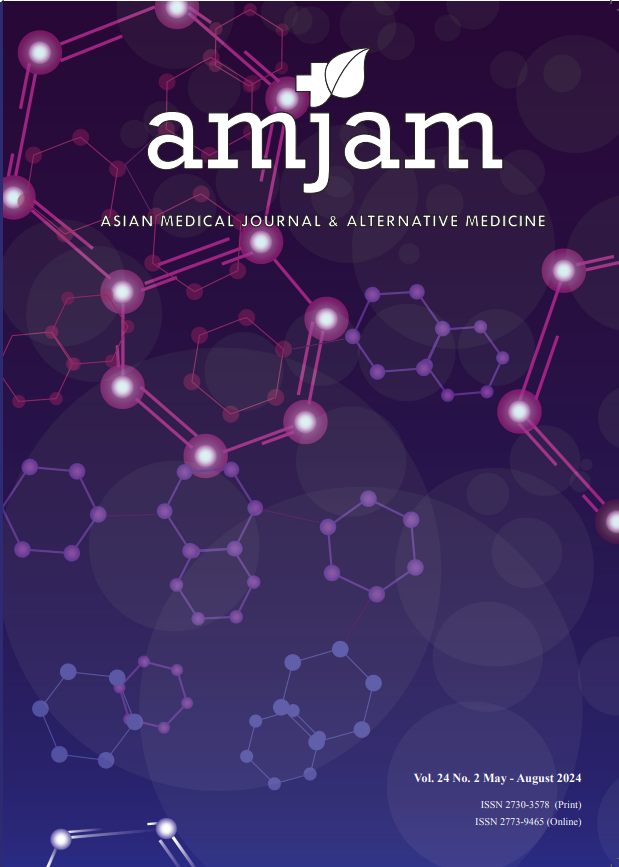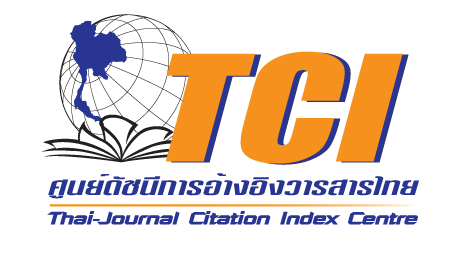Correlation of Size and Redness of Pterygium on Tear Film and Dry Eye Symptoms
Keywords:
Size, Redness, Pterygium, Tear film, Dry eye symptomsAbstract
Purpose: This study aimed to investigate the correlation of size and redness of pterygium to tear film and dry eye symptoms.
Setting/Venue: Thammasat University Hospital, Thailand
Materials and Methods: 976 patients joined a hospital-based, retrospective cross-sectional study in Thammasat University Hospital. Severity of pterygium was measured and collected by size and redness; Tear film was measured and collected by Tear meniscus height (TMH) and Tear break up time (TBUT); Dry eye syndrome was measured and collected by Ocular surface visual analogue scale (VAS), Ocular Surface Disease Index (OSDI), Oxford corneal staining scale and Meibomian gland dysfunction grading. The study was analyzed for correlation, using statistical tools of simple linear regression, Pearson correlation and Anova.
Results: 328 pterygium patients were identified, and information collected. The average horizontal and vertical size of pterygium was 2.74 mm and 2.45 clock hours. The most common redness grading was intermediate (176/328:53.66%). The relationship between horizontal size, vertical size and redness of pterygium with dry eye symptoms and tear film was (R = 0.32, 0.29 and 0.64) with a significance of <0.001, 0.005 and <0.001. The strongest correlation found was in redness of pterygium with OSDI scores, TBUT and Oxford corneal staining scale (R = 0.58, -0.46 and 0.38) with a significance of <0.001.
Conclusions: Pterygium patients were found to be 33.6 percent in this hospital based, retrospective cross-sectional study. Horizontal size, Vertical size and redness of pterygium were related to tear film and dry eye symptoms. Redness of pterygium was the most important clinical feature affecting tear film and dry eye symptoms.
Downloads
References
Bradley JC, Yang W, Bradley RH, et al. The science of pterygia. Br J Ophthalmol. 2010;94(7):815-20.
Liu L, Wu J, Geng J, Yuan Z, Huang D. Geographical prevalence and risk factors for pterygium: a systematic review and meta analysis. BMJ Open. 2013;3:e003787.
Droutsas K, Sekundo W. Epidemiology of pterygium. A review. Ophthalmologe. 2010;107:511-2.
Errais K, Bouden J, Mili-Boussen I, et al. Effect of pterygium surgery on corneal topography. Eur J Ophthalmol. 2008;18(2):177-81.
Marmamula S, Khanna RC, Rao GN. Population-Based Assessment of Prevalence and Risk Factors for Pterygium in the South Indian State of Andhra Pradesh: The Andhra Pradesh Eye Disease StudyPterygium in South India-APEDS. Invest Ophthalmol Vis Sci. 2013;54(8):5359-66.
Asokan R, Venkatasubbu RS, Velumuri L, et al. Prevalence and associated factors for pterygium and pinguecula in a South Indian population. Ophthalmic Physiol Opt. 2012;32(1):39- 44.
Landers J, Henderson T, Craig J. Prevalence of pterygium in indigenous Australians within central Australia: the Central Australian Ocular Health Study. Clin Exp Ophthalmol. 2011;39(7):604-6.
Pyo EY, Mun GH, Yoon KC. The prevalence and risk factors for pterygium in South Korea: the Korea National Health and Nutrition Examination Survey (KNHANES) 2009-2010. Epidemiol Health. 2016;38:e2016015.
Sherwin JC, Hewitt AW, Kearns LS, et al. The association between pterygium and conjunctival ultraviolet autofluorescence: the Norfolk Island Eye Study. Acta Ophthalmol. 2013;91(4):363-70.
Ishioka M, Shimmura S, Yagi Y, Tsubota K. Pterygium and dry eye. Ophthalmologica. 2001;215(3):209-11.
Craig JP, Nichols KK, Akpek EK, et al. TFOS DEWS II Definition and Classification Report. Ocul Surf. 2017;15(3):276–283.
Schiffman RM, Walt JG, Jacobsen G, et al. Utility assessment among patients with dry eye disease. Ophthalmology. 2003;110(7):1412-1419.
Van Tilborg MM, Murphy PJ, Evans KS. Impact of dry eye symptoms and daily activities in a modern office. Optometry and vision science: official publication of the American Academy of Optometry. 2017;94(6):688-93.
Sheppard AL, Wolffsohn JS. Digital eye strain: prevalence, measurement and amelioration. BMJ Open Ophthalmology. 2018;3(1):e000146.
Lekhanont K, Rojanaporn D, Chuck RS, Vongthongsri A. Prevalence of dry eye in Bangkok, Thailand. Cornea. 2006;25(10):1162-7.
Kasetsuwan N, Suwan-Apichon O, Lekhanont K, Chuckpaiwong V, Reinprayoon U, Chantra S, Puangsricharern V, Pariyakanok L, Prabhasawat P, Tesavibul N, Chaidaroon W, Tananuvat N, Hirunpat C, Prakairungthong N, Sansanayudh W, Chirapapaisan C, Phrueksaudomchai P. Assessing the Risk Factors For Diagnosed Symptomatic Dry Eye Using a Smartphone App: Cross-sectional Study. JMIR mHealth and uHealth. 2022;10(6):e31011.
Phruksaudomchai P, Vongkittirux S, Kampitak K. Symptoms of ocular surface affecting the daily life in patients with pterygium. Thai J Ophthalmol. 2018;70-87.
Kucuk E, Yilmaz U, Zor KR. Tear Film Functions and Dry Eye Symptoms in Young Patients with Pterygium. Beyoglu Eye J. 2020;5(1):26-31.
Tan J, Vollmer-Conna U, Tat L, Coroneo M. Dry-Eye Disease in Recurrent Pterygium. Ophthalmic Res. 2019;61(4):199-203.
Wu H, Lin Z, Yang F, Fang X, Dong N, Luo S, Shang X, Li W, Liu Z. Meibomian Gland Dysfunction Correlates to the Tear Film Instability and Ocular Discomfort in Patients with Pterygium. Sci Rep. 2017;7:45115.
Grubbs JR Jr, Tolleson-Rinehart S, Huynh K, Davis RM. A review of quality of life measures in dry eye questionnaires. Cornea. 2014;33(2):215-8.
Tan DT, Chee SP, Dear KB, Lim AS. Effect of pterygium morphology on pterygium recurrence in a controlled trial comparing conjunctival autografting with bare sclera excision. Arch Ophthalmol. 1997;115(10):1235-40.
Phrueksaudomchai P, Tattiyakul W. Prevalence and Associated Factors of Depression in Patients with Pterygium at Thammasat University Hospital. J Med Assoc Thai. 2020;103:45.
Phrueksaudomchai P, Tangpakasit W, Kanchanaranya N. Relationship between Time Length of Digital Device Usage and Dry Eye in Pterygium Patients. J Med Assoc Thai. 2020;103:27.
Rezvan F, Khabazkhoob M, Hooshmand E, Yekta A, Saatchi M, Hashemi H. Prevalence and risk factors of pterygium: a systematic review and meta-analysis. Surv Ophthalmol. 2018;63(5):719-735.
Qian L, Wei W. Identified risk factors for dry eye syndrome: A systematic review and meta-analysis. PLoS One. 2022;17(8):e0271267.
Malozhen SA, Trufanov SV, Krakhmaleva DA. Pterigium: étiologiia, patogenez, lechenie [Pterygium: etiology, pathogenesis, treatment]. Vestn Oftalmol. 2017;133(5):76-83.
Ozsutcu M, Arslan B, Erdur SK, Gulkilik G, Kocabora SM, Muftuoglu O. Tear osmolarity and tear film parameters in patients with unilateral pterygium. Cornea. 2014;33(11):1174-8.
Downloads
Published
How to Cite
Issue
Section
License
Copyright (c) 2024 Asian Medical Journal and Alternative Medicine

This work is licensed under a Creative Commons Attribution-NonCommercial-NoDerivatives 4.0 International License.



